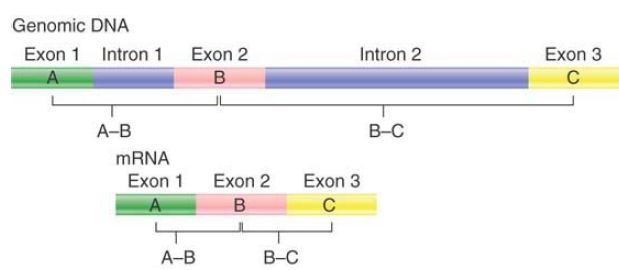
An Interrupted Gene Has Exons and Introns
 المؤلف:
JOCELYN E. KREBS, ELLIOTT S. GOLDSTEIN and STEPHEN T. KILPATRICK
المؤلف:
JOCELYN E. KREBS, ELLIOTT S. GOLDSTEIN and STEPHEN T. KILPATRICK
 المصدر:
LEWIN’S GENES XII
المصدر:
LEWIN’S GENES XII
 الجزء والصفحة:
الجزء والصفحة:
 8-3-2021
8-3-2021
 2437
2437
An Interrupted Gene Has Exons and Introns
KEY CONCEPTS
-Introns are removed by RNA splicing, which occurs in cis in individual RNA molecules.
-Mutations in exons can affect polypeptide sequence; mutations in introns can affect RNA processing and hence can influence the sequence and/or production of a polypeptide.
How does the existence of introns change our view of the gene? During splicing, the exons are always joined together in the same order they are found in the original DNA, so the correspondence between the gene and polypeptide sequences is maintained.
FIGURE 1. shows that the order of exons in a gene remains the same as the order of exons in the processed mRNA, but the distances between sites in the gene do not correspond to the distances between sites in the processed mRNA. The length of a gene is defined by the length of the primary mRNA transcript instead of the length of the mature mRNA. All exons of a gene are on one RNA molecule, and their splicing together is an intramolecular reaction. There is usually no joining of exons carried by different RNA molecules, so there is rarely cross-splicing of sequences. (However, in a process known as trans-splicing, sequences from different mRNAs are ligated together into a single molecule for translation.)

FIGURE 1. Exons remain in the same order in mRNA as in DNA, but distances along the gene do not correspond to distances along the mRNA or polypeptide products. The distance from A–B in the gene is smaller than the distance from B–C, but the distance from A–B in the mRNA (and polypeptide) is greater than the distance from B–C.
Mutations that directly affect the sequence of a polypeptide must occur in exons. What are the effects of mutations in the introns? The introns are not part of the mature mRNA, so mutations in them cannot directly affect the polypeptide sequence. However, they can affect the processing of the mRNA production by inhibiting the splicing of exons. A mutation of this sort acts only on the allele that carries it.
Mutations that affect splicing are usually deleterious. The majority are single-base substitutions at the junctions between introns and exons. They might cause an exon to be left out of the product, cause an intron to be included, or make splicing occur at a different site. The most common outcome is a termination codon that shortens the polypeptide sequence. Thus, intron mutations can affect not only the production of a polypeptide but also its sequence. About 15% of the point mutations that cause human diseases disrupt splicing.
Some eukaryotic genes are not interrupted and, like prokaryotic genes, correspond directly with the polypeptide product. In the yeast Saccharomyces cerevisiae, most genes are uninterrupted. In multicellular eukaryotes most genes are interrupted, and the introns are usually much longer than exons so that genes are considerably larger than their coding regions.
 الاكثر قراءة في مواضيع عامة في الاحياء الجزيئي
الاكثر قراءة في مواضيع عامة في الاحياء الجزيئي
 اخر الاخبار
اخر الاخبار
اخبار العتبة العباسية المقدسة


